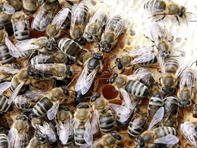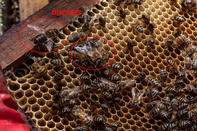The social structures of honeybees are complex - they are social insects and live in large colonies. Each colony contains one fertile female (the queen) and many thousands of worker bees (sterile females), but for a few months during summer a colony will also contain a few hundred males known as drones.

Normally, there are no drones in a colony during the winter months.
At the height of the summer, there can be a population of 50 000 - 60 000 workers in a colony, together with the drones and the queen. Until late autumn most colonies have developing young, (eggs, larvae, pupae), collectively known as a brood. These are reared in wax combs, which also contain the colony’s food stores.
During winter, brood rearing either slows down or stops and the colony lives on the food (honey and pollen) it has gathered and stored up during the summer. In a good year the beekeeper is able to take the excess honey from the colony, leaving enough for the colony to survive through the cold months until the following spring.
Members of the Bee Colony

The honey bee colony and its social structure is quite straighforward - it consists of two female classes, the queen and the worker bee. The males are known as the drone bees. The general structure of the honey bee colony is similar to that of other insects, but each of the three classes (worker, queen and drone) are provided with special structures that are adapted for their specialised roles. In the summer worker bees live for about 6 weeks, but in winter with less work to do, they can live for up to 6 months.
The queen is the largest member of the colony and lives for several years. Her role is to lay eggs to produce more bees. She is the only bee, which can lay fertilised eggs. Her long abdomen contains ovaries that produce large numbers of eggs over long periods of time. The queen is able to determine the sex of the offspring that she produces by controlling the fertilisation of the eggs that she lays.
A fertilized egg will develop into a female bee (worker or queen) and unfertilized eggs develop into males (drones). Having this control is important for the wellbeing of the bee community structure and colony, as a colony has to comprise of a large population of workers to carry out the majority of the work.

The drones are larger than the worker, but not as large as the queen. Their role as the male bees in the colony is to mate with the queen so she can lay fertilised eggs. The drone’s sex organs take up a large part of its abdomen. Drones live for several months during the summer, but are kicked out of the colony when winter comes.
The worker bees do most of the tasks in the colony such as cleaning cells, feeding the brood, producing wax, building combs, ventilating the hive, guarding the entrance, foraging for food and processing nectar into honey. Tasks in the beehive are related to age. For example, the youngest workers tend to act as cleaners within the colony while the oldest workers are the foragers.
Bees in South Africa

There are many different bees in South Africa, with strains of the honeybee and the subspecies that differ in colour, temperament, productivity and their resistance to pests and diseases. Some bees are docile and easy to control while others are aggressive and almost unmanageable. According to South African Bee Industry Organisation (SABIO), South Africa is home to two indigenous sub-species, Apis mellifera Scutellata (or “African bee”) and Apis mellifera Capensis (or “Cape bee”). The Cape bee lives in the fynbos areas of the Western and Southern Cape.
The African bee lives north of this area, but there is overlapping in the two regions and here the Cape bee and the African bee cross-breed. The Cape bee tends to be calmer and darker than the African bee. It is unique in that the Cape worker bees can produce both male and female offspring in a colony, which has become queenless. Cape bees can take over African bee colonies with the Cape worker bees invading and laying their own eggs.
The African bee is aggressive and produces large crops of honey. It has more of a yellow striped abdomen compared to the Cape bee. African worker bees are infertile when the queen is present but can lay unfertilised, drone eggs.